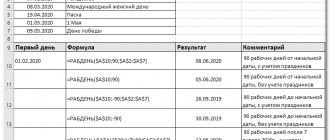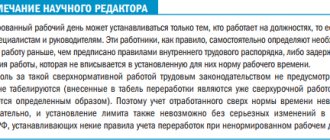How long to work in 2021
Traditionally, working hours standards for 2021 depend on the number of days in 2021. Moreover, these are not only calendar days, but also working days. And also weekends and holidays.
- “What are the postponements of weekends in 2021”
Below is a table with estimated working hours for 2020.
In this 2021 production calendar with working hours, it is given for months, quarters and 2021 as a whole for 40-, 36- and 24-hour work weeks. The number of working days and days off is taken with a 5-day work week with two days off. Also in the last line is the average monthly working time for 2020.
| Periods 2021 | Amount of days | Working hours (in hours) | ||||
| Calendar | Workers | Weekends and holidays | with a 40 hour work week | with a 36-hour work week | with a 24-hour work week | |
| January | 31 | 17 | 14 | 136 | 122.4 | 81.6 |
| February | 29 | 19 | 10 | 152 | 136.8 | 91.2 |
| March | 31 | 21 | 10 | 168 | 151.2 | 100.8 |
| I quarter | 91 | 57 | 34 | 456 | 410.4 | 273.6 |
| April | 30 | 22 | 8 | 175 | 157.4 | 104.6 |
| May | 31 | 17 | 14 | 135 | 121.4 | 80.6 |
| June | 30 | 21 | 9 | 167 | 150.2 | 99.8 |
| II quarter | 91 | 60 | 31 | 477 | 429 | 285 |
| 1st half of the year | 182 | 117 | 65 | 933 | 839.4 | 558.6 |
| July | 31 | 23 | 8 | 184 | 165.6 | 110.4 |
| August | 31 | 21 | 10 | 168 | 151.2 | 100.8 |
| September | 30 | 22 | 8 | 176 | 158.4 | 105.6 |
| III quarter | 92 | 66 | 26 | 528 | 475.2 | 316.8 |
| October | 31 | 22 | 9 | 176 | 158.4 | 105.6 |
| November | 30 | 20 | 10 | 159 | 143 | 95 |
| December | 31 | 23 | 8 | 183 | 164.6 | 109.4 |
| IV quarter | 92 | 65 | 27 | 518 | 466 | 310 |
| 2nd half of the year | 184 | 131 | 53 | 1046 | 941.2 | 626.8 |
| All 2021 | 366 | 248 | 118 | 1979 | 1780.6 | 1185.4 |
| Average monthly working hours | 164.9 | 148.4 | 98.8 | |||
Please note that working hours in January 2021 traditionally differ from other months due to the large number of New Year and Christmas holidays.
REFERENCE
In January 2021, with a 5-day work week with two days off – 17 working days and 14 days off.
The standard working hours in January 2021 will be:
- at 40 hours of work week: 8 hours × 17 days. = 136 h;
- at 36 hours of work week: 7.2 hours × 17 days. = 122.4 hours;
- at 24 hours working week: 4.8 hours × 17 days. = 81.6 hours
For more information about this, see “January 2020: how we rest and work.”
When do hourly rates apply?
Salary calculation based on the number of hours or shifts worked is used in the following cases:
- when calculating fees for overtime and part-time shifts;
- when determining the amount of the basic salary under the tariff system;
- when determining the share of labor contribution of a number of employees under a mixed or lump sum system of remuneration;
- when calculating the amount of payment to business travelers and illegally suspended employees.
Payment for overtime after the end of the shift can only be calculated based on the cost of one hour of work. Payment for a partial shift or for downtime for several hours is also calculated based on the cost of an hour of labor. The working time of each employee is determined by the time sheet, and the salary is determined by the total number of hours worked, the tariff rate and bonus coefficients.
How to determine working hours in 2020
As before, the calculation of working hours for 2021 is regulated by Order No. 588n of the Ministry of Health and Social Development of Russia dated August 13, 2009. It establishes the rules for calculating the norm of working time for certain calendar periods (month, quarter, year) depending on the established length of working time per week (5 days, 6 days, etc.).
It is important that the standard working time for 2020 calculated in this order applies to all work and rest regimes in 2020.
Note that for a six-day week, the standard working time is calculated according to a 5-day workweek schedule with two days off on Saturday and Sunday, based on the duration of daily work (shift).
Article 96. Night work
Night time is the time from 22:00 to 6:00.
The duration of work (shift) at night is reduced by one hour without further work.
(as amended by Federal Law No. 90-FZ of June 30, 2006)
The duration of work (shift) at night is not reduced for employees who have a reduced working time, as well as for employees hired specifically to work at night, unless otherwise provided by the collective agreement.
The duration of work at night is equal to the duration of work during the day in cases where this is necessary due to working conditions, as well as for shift work with a six-day work week with one day off. The list of specified works may be determined by a collective agreement or local regulations.
The following are not allowed to work at night: pregnant women; workers under the age of eighteen, with the exception of persons involved in the creation and (or) performance of artistic works, and other categories of workers in accordance with this Code and other federal laws. Women with children under three years of age, disabled people, workers with disabled children, as well as workers caring for sick members of their families in accordance with a medical certificate issued in the manner established by federal laws and other regulatory legal acts of the Russian Federation , mothers and fathers raising children under the age of five without a spouse, as well as guardians of children of the specified age, may be involved in night work only with their written consent and provided that such work is not prohibited to them for health reasons in accordance with the medical report. At the same time, these employees must be informed in writing of their right to refuse to work at night.
(as amended by Federal Laws dated July 24, 2002 N 97-FZ, dated June 30, 2006 N 90-FZ)
Procedure for night work of creative workers of the media, cinematography organizations, television and video film crews, theaters, theatrical and concert organizations, circuses and other persons involved in the creation and (or) performance (exhibition) of works, in accordance with the lists of works , professions, positions of these workers, approved by the Government of the Russian Federation, taking into account the opinion of the Russian Tripartite Commission for the Regulation of Social and Labor Relations, can be established by a collective agreement, a local regulatory act, or an employment contract.
(as amended by Federal Laws dated June 30, 2006 N 90-FZ, dated February 28, 2008 N 13-FZ)
Features of 2021
According to the law, the duration of the working day or shift immediately before a non-working holiday is subject to reduction by 1 hour (Part 1 of Article 95 of the Labor Code of the Russian Federation).
In 2021, we will work 1 hour less on April 30, May 8, June 11, November 3, December 31.
That is, on the eve of the holidays May 1 and 9, June 12, November 4, 2020, as well as January 1, 2021.
When, by decision of the Government of the Russian Federation, a day off is moved to a working day, the duration of work on this former day off must correspond to the duration of the working day to which the day off was transferred.
As a result, in total in 2021, for employees with a 5-day work week, there will be 5 working days with a reduced duration of 1 hour.
Finally, we note that the number of working days in 2021 compared to 2021 is 1 day more, and the number of weekends and holidays in 2021 and 2021 is the same.
Read also
27.03.2020
How to calculate the norm for summarized accounting
Cumulative accounting is a labor regime of a special nature, which is based on established schedules.
The payment option for work is determined by the employer. It can be:
- hourly rate (calculated based on the number of hours worked in a particular month);
- official salary (fixed amounts paid every month).
When installing summarized accounting, you should select the optimal accounting period: month, quarter or year. In this situation, the employer chooses. A period exceeding one year is not provided.
When introducing summarized accounting, the following must be observed:
- The regime is being implemented in those institutions where it is not possible to establish compliance with working hours on an ongoing basis.
- The amount of work time for a specified period cannot exceed the standards provided for by law.
- Compliance with the schedule is mandatory.
- The duration of overtime work is calculated at the end of the accounting period.
Special conditions when calculating payments
An easy formula will help you correctly calculate payments when going on vacation. Aspects requiring clarification:
- If the employee received bonuses and rewards for the pay period, this is also added when calculating the average daily earnings.
Average - In the case where a worker takes unused vacation for the previous year, we take into account the earnings of this year, and not the year when the vacation was not taken. And it is the average daily salary for the current year that is multiplied by 56, or another length of vacation.
- To calculate the average daily salary, other payments are also added to the basic salary, namely previous vacation pay (if they relate to the billing period), business trips.
- If production downtime occurs through no fault of the worker, then the period is not included in the calculation.
- If the work week is incomplete, that is, 2-4 days, then only those days when you worked are taken into account. If it is the employee’s desire not to work the full working week, then all days, even when he/she did not work, are included in the pay period. We don't exclude weekends.
The legislative framework
The Labor Code of the Russian Federation has a fairly specific definition regarding working time standards. The vast majority of workers work eight hours a day and work forty hours a week. This situation is due to the fact that organizations and enterprises work mainly five days a week. The working day is usually eight hours a day.
In this regard, future employees who are seeking employment can be advised to carefully familiarize themselves with the work schedule at the enterprise or organization. Often, it is during an interview that a potential employee’s length of working day is determined.
Example and procedure for calculating vacation pay
Vacation payments are essentially the same salary, only they are calculated for the time when you do not go to work.
Calculation procedure
According to Article 74 of the Labor Code, workers have paid leave every year. It is given with retention of salary and position. During your vacation, you are required to accrue vacation pay; its amount is approximately equal to your salary for the same time. They are easy to calculate. Even for a person who knows nothing about accounting, there is a completely simple formula: vacation pay = the amount of payments for the reporting period is divided by the number of days, and multiplied by the number of days of the vacation period.
That is, the amount of vacation payments depends on the average daily earnings during the previous period. To do this, you need to calculate the total income for the working year, and then divide it by the number of days. For this purpose, we subtract non-working days from the number of calendar days for a certain period. This is how we calculate the average daily salary. To find out the amount of vacation pay, multiply the resulting number by the number of days in the calendar for the vacation period.
Legal regulation of labor regulations
Chapter 15 of the Labor Code of the Russian Federation is fully devoted to the regulation of working time. It provides standards, limits depending on the category of employees, calculation and reporting of the organization. The law protects the rights of citizens, implementing the constitutional principle of a welfare state.
In particular, it establishes the maximum weekly work duration allowed in the Russian Federation. Usually it is divided by 5, according to the daily period. It is 8 hours or 40 hours per week. This is a basic provision that cannot be violated. If staff are forced to work more, they have the right to appeal to government agencies. The latter conduct an inspection, after which the company is obliged to bring its internal regulations into compliance with the current rules.
It is important to know! Sometimes the specified norm may be exceeded. Such situations are also reflected in the legislation, which provides for several working hours. We are talking about working above the norm, taking into account the characteristics of the enterprise, seasonal and regional specifics.
The federal government determines the calculation of the working period, distributing standards across time periods. This could be a month, a quarter, a year. The basic unit remains the week and the number of hours for the specified period. The management of the enterprise must keep records reflecting the time spent by employees performing their duties. Based on this, inspection organizations draw conclusions. The discrepancy between the information entered and the actual conditions becomes a reason for verification. Detected violations will result in penalties and sanctions.
Current regulations provide for:
- Five days. Employees work 5 days a week. As a rule, Saturday and Sunday are reserved for rest;
- Six days. In this case, only 1 day a week is a day off;
- Flexible schedule. Weekends are sliding, work can be carried out on the principle of 2/2, 3/3, etc. The number of hours usually exceeds 8, compensated by a large number of days off and their early onset.
In some industries, as well as for certain categories of employees, the rules may differ.
Legislative basis
Chapters 15 and 16 of the Labor Code and the Russian Federation are fully devoted to regulating the issue. In the 15th, general provisions are given, and in the 16th, the definition of working hours is indicated and acceptable options for the work schedule are given. The company's management is obliged to adhere to these standards; violation is fraught with intervention from regulatory authorities.
Basic provisions
In general, the law is quite flexible, leaving organizations room to maneuver. They can independently create a schedule for their activities, taking into account the working day according to the Labor Code. One of the basic rules remains the limit of 40 weekly hours or 8 hours every day. This is the optimal norm adopted in most countries pursuing social policies and caring for the population.
The specified duration allows organizations to solve problems and employees to cope with responsibilities, leaving them time to rest. Its minimum limit is 42 hours per week, starting from the end of the working day on Friday. Sometimes this may be a different day if the company has staggered holidays. The rules allow such a schedule.
Working time is considered to include both the direct performance by personnel of the functions assigned to them and preparation for the process. This is especially important with shifts and irregular schedules, when a piece-rate form of payment is used. That is, the company is obliged to pay not only for the result, but also for the preparatory actions. All of them are included in working hours, as well as a medical examination.
In this case, the journey to and from work is not included in the specified period and is not paid, as well as a lunch break and time spent changing clothes. When drawing up a schedule, several types of working hours and daily routines must be taken into account. This is done taking into account the interests of certain categories of employees whose rights are protected by law.
Regardless of whether an employee belongs to them, the management of the organization as a whole is obliged to establish a regime that ensures productive work and proper rest. First of all, this is a break between shifts and weekly days off. Usually the accepted standards reflect the agreement of the parties.
Existing types of working time
There are several ways to organize a working period. It is customary to highlight:
- Standard duration. This is a basic 40 hours per week or 8 hour work day;
- Partial day. Established at the request of an employee belonging to a certain category of citizens: disabled people, minors, pregnant women. As an option, part-time is initially specified in the agreement. Payment is proportional to the period worked or the volume of tasks (in the case of piecework);
- Daily work. In this case, the employee’s time at production is 24 hours, and he has the right to increased pay;
- Short format. It is also provided for certain categories of employees. The difference is the duration is less than 40 hours per week;
- Working overtime. They may be called upon occasionally, but only if this form is specified in the agreement of the parties. Management issues a written order; employee consent is not required;
- Irregular day. It is applied taking into account seasonal, regional and immediate specifics on site. Regardless of the reasons, higher rates apply.
It is important to know! In some cases, the norm is reduced by professional specifics. For example, drivers are required to periodically rest with warm-up exercises. Ignoring or violating the prescribed standards by the company allows employees to appeal to government agencies and the court.
Legal working hours
The norm is prescribed in Article 91 of the Labor Code of the Russian Federation, where it is specified as the actual period worked by the employee per day or other time period. Accordingly, when asking how long a person must work under the Labor Code, it is necessary to take into account this and other provisions.
There is no single standard (excluding the 40-hour weekly limit), since there are several categories of workers who may qualify for relief. Some are prohibited from working at night, others are given more time to rest, etc. All this is connected with the need to provide the citizen with proper rest, excluding physical and psychological overload.
For example, a minor employee cannot work more than:
- 4 hours if he is 14 years old;
- 5 hours if he is 15 years old;
- 7 hours if he is 16-18 years old.
If the work is carried out in parallel with training, the shift will be 2.5 hours for 14-16 year olds and 4 hours for 16-18 year olds.
Similar concessions are provided for citizens with health problems, namely confirmed disabilities. Specific numbers depend on the type and degree of the disease, but in any case, a disabled person has the right to request a part-time day. In addition, restrictions are imposed on certain types of work, such as carrying heavy objects.
When indicating how long a working day is under the Labor Code, the law takes into account individual professions and areas of activity related to the performance of life-threatening work. They are limited to 30 hours per week; an increase to 8 hours per day is allowed only with the consent of the citizen.
Advice! A pregnant woman and employees caring for a child with a disability have the right to work part-time. The number of hours is established by agreement of the parties. If there are circumstances (a person’s relationship to a specific category), management has no right to refuse.
A time limit is provided for citizens carrying out part-time work. It is 4 hours for additional work. If a person loses their main job, they can go full-time.
As for payment, it is made for the time actually worked or the volume completed (in the case of piecework). A reduced rate cannot be applied, this is discrimination. A reduced working day according to the Labor Code does not deprive a person of the right to vacation and other benefits.
Average number of working days per month for calculating vacation pay
We present to your attention the current formula for calculating vacation pay:
Amount of vacation pay = Average earnings per day * Number of vacation days
Vacation pay calculation
The amount of vacation pay also depends on the increase or decrease in the rate.
Vacation days are usually counted by calendar days. In total, the employee is credited with 28 days. Moreover, the employee does not necessarily have to leave for the entire period at once, but can take time off in parts throughout the year.
Workers who have not reached the age of majority must have 31 days of leave, and people with disabilities 30 days.
Let's define the term “working time”
IMPORTANT! Recommendations for recording working hours from ConsultantPlus are available here
Art. 91 of the Labor Code of the Russian Federation gives a fairly strict definition of this term. Working time is the period during which hired personnel must perform their functional duties, regulated in the terms of the employment contract and internal labor regulations.
Working time also includes some other periods that are considered as such in accordance with legislative acts, namely:
- forced downtime;
- shift change;
- being on a business trip;
- break for lunch, if you cannot leave your workplace at this time;
- special breaks for workers during cold periods of the year, during loading operations, etc.;
- when delivering by company transport - travel time to and from work, etc.
What is rest time according to the Labor Code of the Russian Federation?
By rest time, labor legislation understands periods when an employee is released from work duties and has the right to use them at his own discretion. These are the following breaks:
- during the work shift (lunch, special: provided within the framework of the law to nursing women, workers in cold working conditions for heating, air traffic controllers);
- between shifts;
- weekend;
- holidays recognized as non-working days by labor legislation;
- vacations: annual paid and additional.









